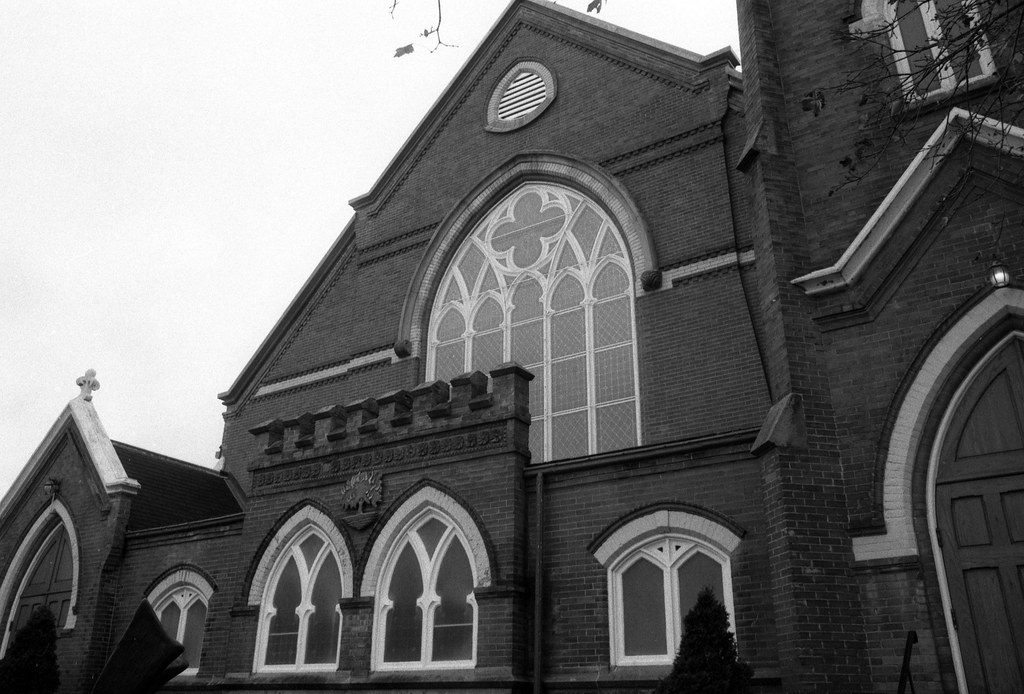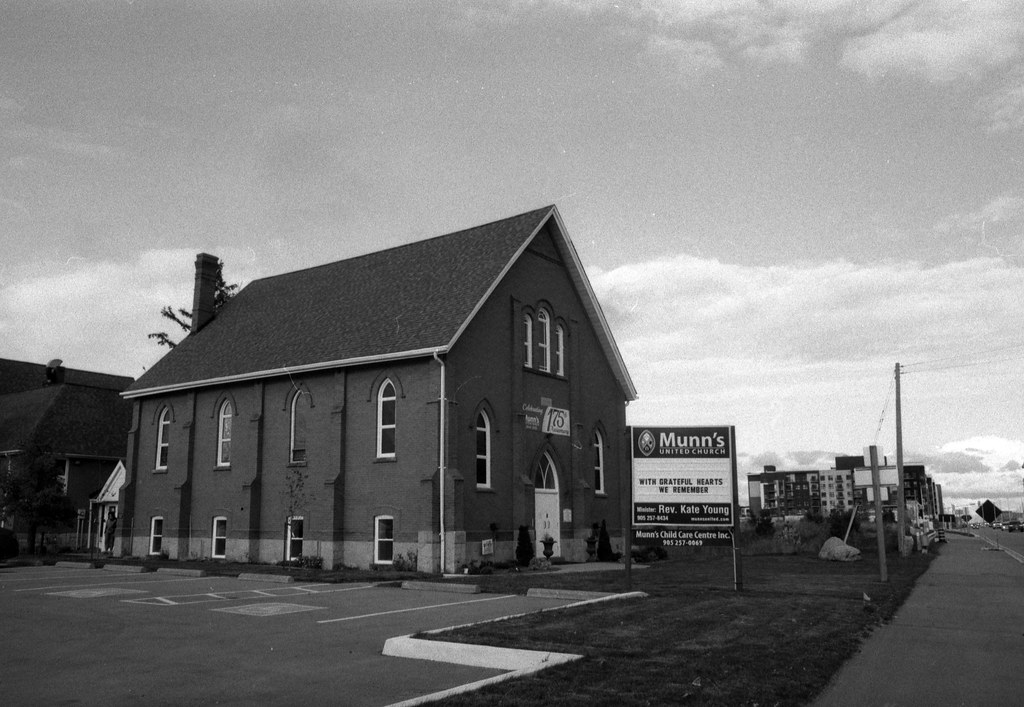This week is a bit of a throwback, not to this project, but my first photography project! In my last year in High School, I took a Media English course that included a photography element. We learned how to process and print black & white film during the period, and the final project from that section had a photo project. I chose to work with documenting the churches in Milton. So this week, we’re visiting churches in both Oakville and Milton, not only the ones in the community centres but also a couple of rural churches.

Nikon FM – AI Nikkor 28mm 1:3.5 – New Classic EZ400 @ ASA-400 – Adox Atomal 49 (Stock) 10:00 @ 20C
Human spirituality has been around for as long as humans have been around. There’s evidence of worship reaching far back into the dark days of pre-history. Here in North America, the first civilizations to take root and build a life carried a deep sense of spirituality. Weaving tales of the Earth Diver or a massive Turtle to speak of the creation of the Earth. The Spirit and Natural worlds intertwined, told through story and dance around a sacred fire passed these tales and traditions down through generations. They found the divine in nature, places, and animals. The arrival of European Explorers brought Christianity across from Europe, John Cabot planting an English flag along with the banners of the Pope and Vatican claiming what is today Newfoundland in the name of King Henry VI and the Roman Church. And where Europeans went, the Roman Catholic Church followed, settlers and missionaries alike spread Catholicism among the Indigenous People. One of the most prolific Roman Catholic missionaries was those of the Society of Jesus or Jesuits. While much can be said for their actions, and I certainly condemn the forced conversion and violence taken against the Indigenous Peoples, some came and preached the gospel who genuinely wanted to see them receive the Salvation offered by Christ. The one who stands out the most here in North America is Jean de Brébeuf. Brébeuf is mainly noted for his work with the Wendat people, establishing a mission in Wendake, Sainte-Marie-au-pays-des-Hurons. Out of this mission, Brébeuf began intertwining Christian spirituality with those of the Wendat, penning one of my favourite Christmas Carols, the Huron Carol. These early churches met in the homes of those who formed the church. Eventually, log and frame buildings began to spring up. By the time Europeans began settling in Halton County, the denomination of church was determined by the makeup of those settlers. Anglican churches and Presbyterian Churches became the most common where English and Scottish settlements formed, Roman Catholic parishes also followed. Saddlebag preachers from the Methodist churches often rode through rural settlements teaching and leading worship in homes or out in nature. As settlements grew and populations expanded, these frame buildings were replaced by those of brick. The 1880 and 1890s brought grand brick or stone buildings, often following the popular Gothic Revival style. Milton and Oakville were still rural backwaters, so the churches here are mainly in that style with no Cathedrals or grand churches. Even today, these congregations can trace their histories back to the 1830s and are fiercely protective of their buildings. But even today, church buildings are changing with the time, using modern architectural styles and multi-use rooms to continue to serve within their communities.

Nikon FM – AI Nikkor 28mm 1:3.5 – New Classic EZ400 @ ASA-400 – Adox Atomal 49 (Stock) 10:00 @ 20C
Nikon FM – AI Nikkor 28mm 1:3.5 – New Classic EZ400 @ ASA-400 – Adox Atomal 49 (Stock) 10:00 @ 20C
I’ll get this right out in the open first; yes, all these images are of Christian Churches; I wish I could have included a far more diverse selection of sacred spaces for the project. But despite all the expansion and changes in the makeup of the populations of Milton and Oakville, Christian churches of various denominations make up these Houses of Holy. That’s not to say there aren’t spaces for other beliefs in my area; my travels were not near those spaces this week. While this week presents a narrow view, I recognize more than a Judeo-Christian within Canada, Ontario, and Halton Region today. The featured image should come as no surprise as I have the most connection to Knox Church in Milton, having been born and raised in the congregation and continuing to worship here and help serve the congregation. From there, I went with two more downtown Churches in Milton, Grace Anglican, because the current sanctuary is excellent, and Southside Community Church, a congregation that, thanks to their Bible Studies and other programs, I met Heather through. I included two formerly rural churches, Munn’s United and Omagh Presbyterian, that today face being surrounded by the slowly spreading urban sprawl but continue to serve. Then into downtown Oakville, with the beautiful but challenging to photograph St. Jude’s Anglican church and Knox Presbyterian, a church that I’ve worshipped with on a few occasions now.

Nikon FM – AI Nikkor 28mm 1:3.5 – New Classic EZ400 @ ASA-400 – Adox Atomal 49 (Stock) 10:00 @ 20C
Nikon FM – AI Nikkor 28mm 1:3.5 – New Classic EZ400 @ ASA-400 – Adox Atomal 49 (Stock) 10:00 @ 20C
For this week, we’re continuing to work with New Classic EZ400, and unlike past times with this film, I’m shooting it at the full box speed of ASA-400. Not a common way I shoot this film stock, but I needed a bit of an extra boost in speed shooting over three days. For the developer, I had initially wanted to go with Ilford Microphen, great for compensating any over/under exposure and then push/pull processing. I thought I had a box sitting waiting to be mixed up, but instead of Microphen, I had Perceptol. But I did have a pouch of Adox Atomal 49 waiting, so I went with that instead. Result Comments Here. As I was shooting mainly architectural work, I went with the old favourite, Nikkor 28mm f/3.5 lens. While the 24mm may have been slightly better, I didn’t want the results to be too wide, although that 24mm might have worked in a couple of cases. But overall, the 28mm gave me enough room to play.

Nikon FM – AI Nikkor 28mm 1:3.5 – New Classic EZ400 @ ASA-400 – Adox Atomal 49 (Stock) 10:00 @ 20C
Nikon FM – AI Nikkor 28mm 1:3.5 – New Classic EZ400 @ ASA-400 – Adox Atomal 49 (Stock) 10:00 @ 20C
Next week we’re visiting Milton’s biggest rival, at least it was when I was in school! We’re heading back into Halton Hills to answer the age-old question. Is it worth the drive to Acton?